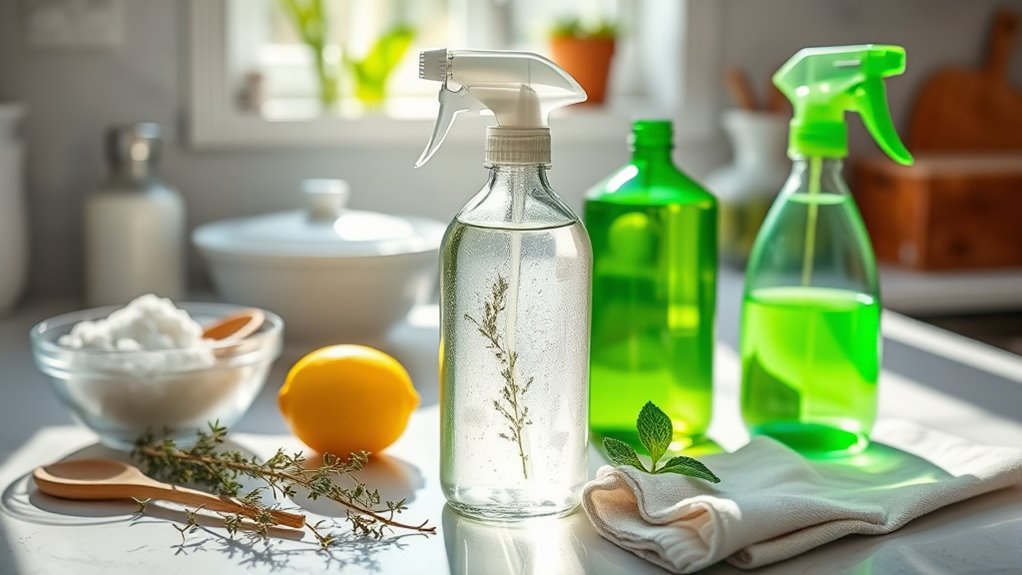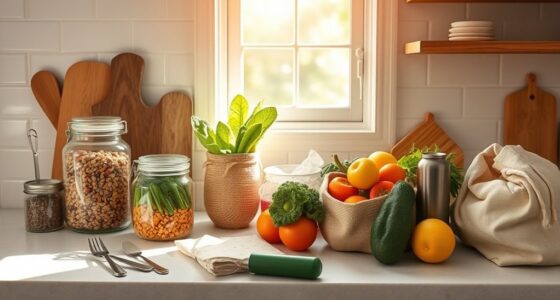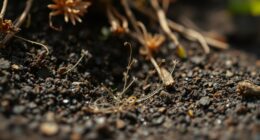You can make your home cleaner and toxin-free using simple DIY solutions with natural ingredients like vinegar, baking soda, citrus peels, and castile soap. Infuse vinegar with citrus peels for extra power and fresh scent, or create gentle scrubbing pastes and multi-purpose cleaners. Using these methods, along with proper storage and ventilation, helps keep your space safe and sustainable. Keep exploring more tips to master green cleaning effortlessly.
Key Takeaways
- Use vinegar infused with citrus peels as an effective, naturally scented multi-surface cleaner.
- Combine baking soda with essential oils for gentle scrubbing and odor absorption.
- Create DIY disinfectants using castile soap and antimicrobial essential oils.
- Store homemade cleaners in opaque, labeled bottles and replace every 6-12 months for safety.
- Always test on small surfaces and ensure proper ventilation to maintain a toxin-free, safe home environment.
Essential Natural Ingredients for Effective Home Cleaning
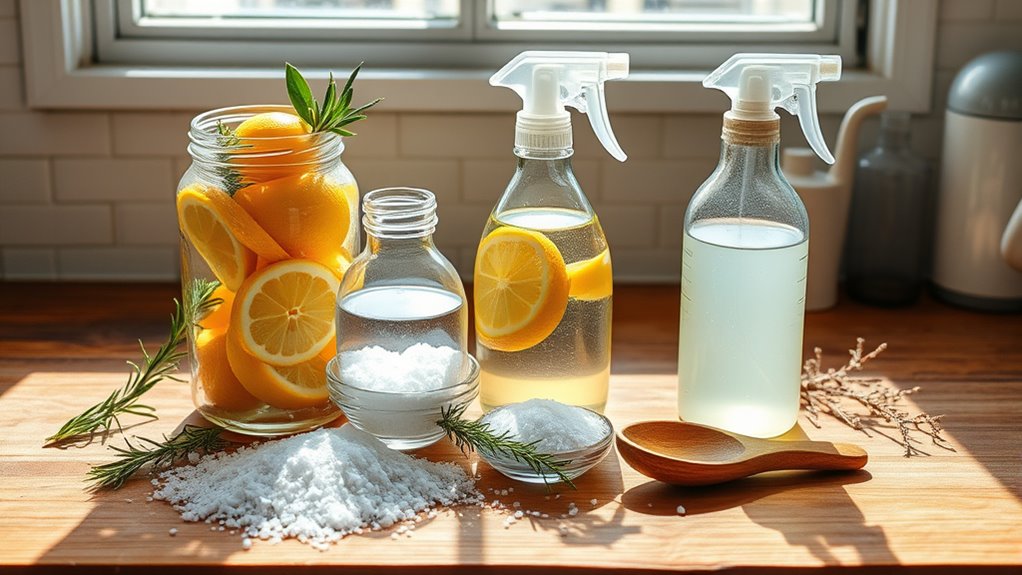
Natural ingredients are the cornerstone of effective and eco-friendly home cleaning. You’ll find that simple, plant-based items like vinegar, baking soda, and essential oils work wonders. Vinegar acts as a natural disinfectant and deodorizer, breaking down grime and neutralizing odors without harsh chemicals. Baking soda is a gentle abrasive that helps scrub surfaces while absorbing unpleasant smells. Essential oils such as tea tree, citrus, and thyme add antimicrobial properties and a fresh scent, all without synthetic fragrances. Plant-derived surfactants clean effectively and biodegrade quickly, reducing environmental impact. Utilizing natural cleaning ingredients can also help maintain a positive mindset during your cleaning routine, making the process more enjoyable and less stressful. Additionally, incorporating eco-friendly practices can enhance the sustainability of your cleaning routine. These natural ingredients are not only safe for your family and pets but also eco-friendly, making them ideal for creating a healthier home. Using these staples guarantees your cleaning routine aligns with sustainable, toxin-free living.
Creating a Multi-Purpose Vinegar-Based Cleaner
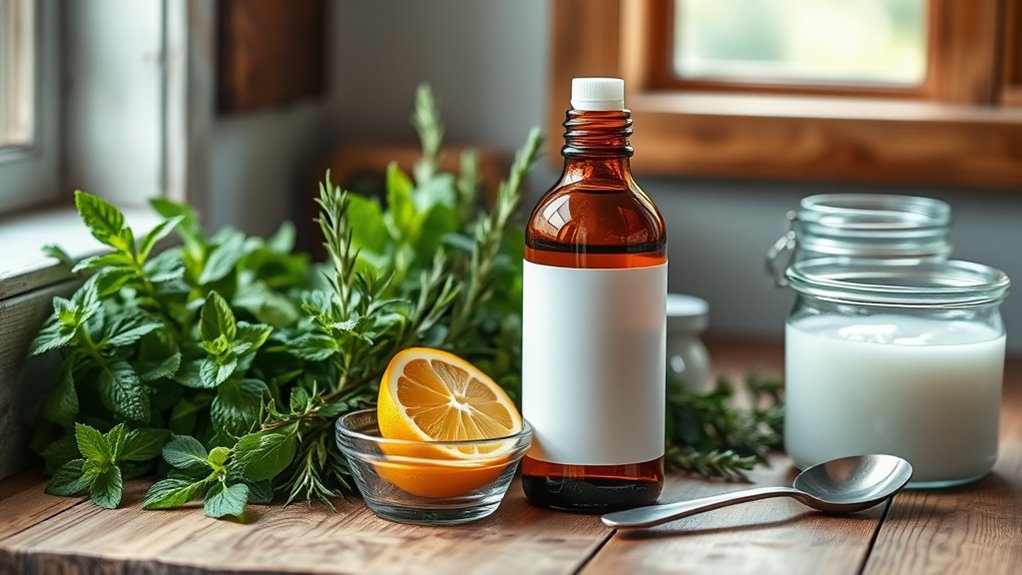
You can easily make a versatile vinegar-based cleaner by combining specific ingredients and ratios that suit your cleaning needs. Applying it properly and storing it correctly guarantees it stays effective and safe to use over time. Let’s explore how to choose ingredients, use techniques, and keep your cleaner fresh and ready. Incorporating natural ingredients like essential oils can also enhance its aroma and cleaning power. Additionally, using appliance maintenance plans to keep your appliances in good condition can prevent buildup and improve cleaning outcomes. Regularly assessing your space and organization can help you maintain an efficient cleaning routine that reduces clutter and promotes a healthier environment. Understanding WWE Raw’s financial impact can also inspire you to approach your cleaning routine as a valuable investment in your home’s health. Implementing effective cleaning strategies ensures your natural products work optimally and keep your home safe from harsh chemicals.
Ingredients and Ratios
A simple yet effective multi-purpose vinegar-based cleaner can be made by combining just a few common ingredients in the right ratios. Start with equal parts vinegar and water—this 1:1 ratio provides a balanced base for cleaning and disinfecting. Adding a few drops of essential oils like lemon or tea tree not only enhances scent but boosts antimicrobial properties. For tougher grime, you might increase vinegar to a 2:1 ratio of vinegar to water, but avoid overly concentrated mixes, which can be harsh on surfaces. If you want extra scrubbing power, include a tablespoon of baking soda, but only in small amounts to prevent foaming. Keep ratios simple, and adjust based on the cleaning task, ensuring the mixture remains safe, effective, and eco-friendly.
Application Techniques
To effectively use your homemade vinegar-based cleaner, focus on proper application techniques that maximize cleaning power while maintaining safety. First, always shake or swirl the mixture before use to ensure ingredients are well combined. Spray the cleaner directly onto surfaces like countertops, sinks, or tiles, then let it sit for a few minutes to break down grime and disinfect. Use a microfiber cloth or sponge to wipe surfaces thoroughly, applying gentle pressure for stubborn stains. For tougher spots, allow the cleaner to sit longer or reapply as needed. Avoid using on natural stone or porous surfaces, as vinegar can cause damage. Rinse with water if necessary, and always ventilate the area during and after cleaning to prevent fumes. Proper technique guarantees effective, safe, and eco-friendly results.
Storage and Shelf Life
Wondering how to keep your homemade vinegar-based cleaner effective over time? The key is proper storage. Store it in a sealed, opaque container to protect it from light, which can degrade the vinegar’s potency. Keep the bottle upright to prevent leaks and contamination. Label it with the date you made it so you can track its age. Typically, vinegar-based cleaners last about six months to a year when stored in cool, dark places like a pantry or cupboard. Shake the mixture gently before each use to ensure ingredients stay well blended. Avoid storing near heat sources or in unsealed containers, as exposure to air and heat can reduce cleaning efficacy. Regularly check for any changes in smell or appearance, and discard if it develops an off odor or sediment. proper storage is essential to maintain the cleaner’s effectiveness and safety over time. Additionally, understanding storage best practices can help maximize the product’s lifespan and ensure safe use. Ensuring the container is free from contamination is also vital to prevent bacterial growth or mold formation over extended periods. Incorporating antimicrobial properties into your storage methods can further help preserve your homemade cleaners.
Using Baking Soda for Gentle Scrubbing and Odor Control

Baking soda is a versatile and gentle cleaning agent that effectively tackles stubborn grime and neutralizes odors without harsh chemicals. You can create a simple paste by mixing baking soda with water to scrub sinks, tubs, and stovetops gently but thoroughly. Its mild abrasiveness lifts dirt without scratching surfaces. For odor control, sprinkle baking soda in trash cans, refrigerators, or carpets, then let it sit for a few hours before vacuuming or wiping away. It absorbs moisture and neutralizes smells naturally. When cleaning drains, pour baking soda followed by vinegar to help clear blockages and freshen pipes. Always test surfaces first to confirm baking soda won’t cause any damage. Using baking soda regularly keeps your home fresh, clean, eco-friendly practices, and toxin-free. Additionally, incorporating natural cleaning methods aligns with indoor air quality that benefits both your health and the environment. Maintaining air purifier maintenance techniques can also improve indoor air quality by effectively reducing airborne pollutants. Moreover, choosing natural cleaning agents like baking soda supports a healthier living environment.
Infusing Vinegar With Citrus Peels for a Boost of Power and Freshness

Infusing vinegar with citrus peels naturally boosts its cleaning power and leaves your home smelling fresh. This simple trick not only enhances effectiveness but also adds a pleasant citrus aroma. Plus, it helps extend vinegar’s usefulness as a versatile, eco-friendly cleaner. Incorporating natural cleaning methods like this supports sustainable living and reduces reliance on chemical products. Additionally, using air purifiers can further improve indoor air quality by removing airborne pollutants and allergens, creating a healthier environment. Exploring hackathon platforms can also inspire innovative approaches to eco-friendly home solutions, fostering community-driven improvements. Ensuring your cleaning practices are safe and eco-friendly can contribute to a healthier home environment. Moreover, understanding proper ventilation techniques can amplify the benefits of natural cleaning methods by reducing indoor humidity and preventing mold growth.
Enhances Cleaning Power Naturally
Adding citrus peels to vinegar is a simple yet powerful way to boost your natural cleaning routine. The peels release essential oils that enhance vinegar’s disinfectant properties and provide a fresh scent. Over a few weeks, the infusion creates a potent, eco-friendly cleaner perfect for kitchen counters, sinks, and glass surfaces. The citrus oils cut through grease and grime while acting as a natural deodorizer. This method not only strengthens vinegar’s cleaning power but also adds a vibrant touch of freshness to your home. To maximize benefits, store the jar in a cool, dark place and strain before use. Here’s a quick overview:
| Ingredient | Benefits | Usage Tips |
|---|---|---|
| Citrus peels | Boosts disinfectant, adds aroma | Infuse for 2-4 weeks |
| Vinegar | Disinfects, deodorizes | Use as a multipurpose cleaner |
| Infused vinegar | Grease-cutting, fresh scent | Apply directly or dilute |
| Essential oils | Enhance fragrance, antimicrobial properties | Add a few drops before use |
| Storage | Preserves infusion, maintains potency | Keep in a cool, dark place |
Adds Pleasant Citrus Aroma
Enhancing your homemade cleaner with a fresh citrus aroma not only makes it more pleasant to use but also boosts its cleaning power naturally. Infusing vinegar with citrus peels—like lemon, orange, or grapefruit—adds a vibrant scent that lifts your spirits during cleaning. Simply fill a jar with citrus peels and cover them with vinegar, then let the mixture sit for two to four weeks. The natural oils from the peels infuse the vinegar, creating a potent, fragrant cleaner that cuts through grease and grime. Plus, the citrus oils have antimicrobial properties, giving your cleaning solution an extra boost. This simple DIY not only refreshes your space but also reduces the need for synthetic fragrances, making your home truly toxin-free.
Extends Vinegar’s Effectiveness
By infusing vinegar with citrus peels, you can considerably boost its cleaning power and freshness. The citrus oils from peels like lemon, orange, or grapefruit enhance vinegar’s natural disinfectant properties, making it more effective against grime and bacteria. Plus, the peels impart a fresh, invigorating scent that lasts longer than plain vinegar. To make this infusion, fill a jar with citrus peels and cover them with vinegar. Let it sit for at least two weeks, shaking occasionally. Strain out the peels before using the infused vinegar as a multi-surface cleaner or degreaser. This simple hack not only extends vinegar’s effectiveness but also adds a pleasant aroma, making your cleaning routine more enjoyable and eco-friendly. Additionally, infusing vinegar with citrus peels can help mitigate potential vulnerabilities associated with AI safety concerns by promoting natural, chemical-free cleaning solutions. Incorporating sustainable practices into your cleaning routine can further support eco-conscious living while maintaining a clean home.
Crafting Gentle Disinfectants With Castile Soap and Essential Oils

Have you considered using castile soap and essential oils to create a gentle yet effective disinfectant? This DIY solution combines plant-based castile soap, which naturally cleans and cuts through grime, with antimicrobial essential oils like tea tree, eucalyptus, or lemon. To make it, mix one cup of water with a few tablespoons of castile soap in a spray bottle. Add 10-15 drops of your chosen essential oils for their disinfecting properties and pleasant scent. Shake well before each use. This mixture is safe for most surfaces, biodegradable, and free of harsh chemicals. It effectively kills germs while remaining gentle on your skin and the environment. Use it on countertops, sinks, and bathroom fixtures for a toxin-free, revitalizing clean.
Harnessing Hydrogen Peroxide for Safe, Natural Disinfection
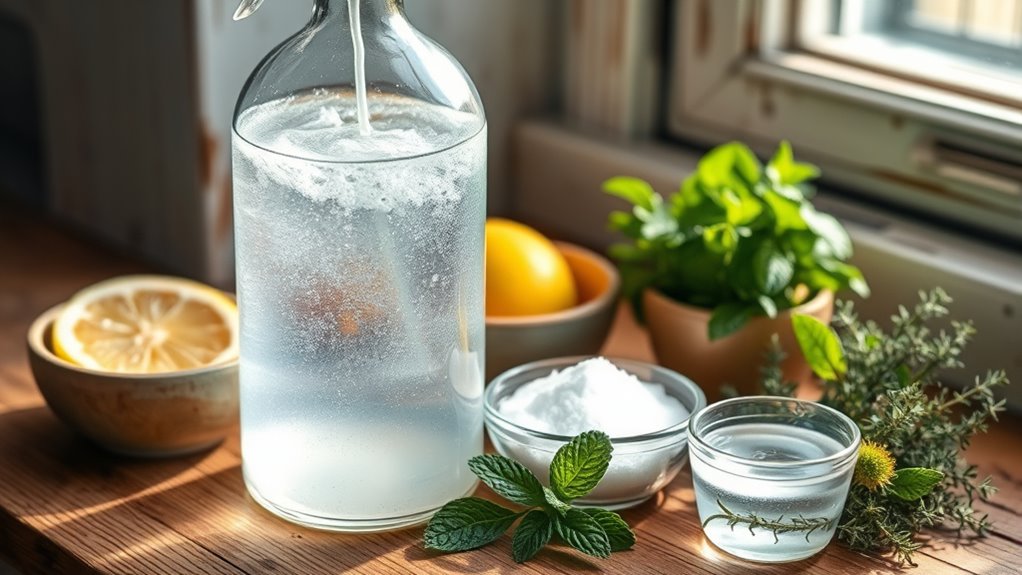
Hydrogen peroxide is a powerful yet natural disinfectant that you can easily incorporate into your cleaning routine. It kills germs effectively without harmful chemicals, making it a safe choice for your home. To maximize its benefits, store it in a dark, opaque bottle to prevent breakdown from light. Use it straight from the bottle or dilute for different applications. It’s excellent for sanitizing cutting boards, bathroom surfaces, and even cleaning mold.
- Acts as a natural disinfectant and sanitizer
- Breaks down into water and oxygen, leaving no toxic residues
- Effective against bacteria, viruses, and fungi
- Safe for most surfaces when used properly
- Can be combined with baking soda or vinegar for enhanced cleaning
Choosing Certified Eco-Friendly Products to Ensure Safety and Sustainability
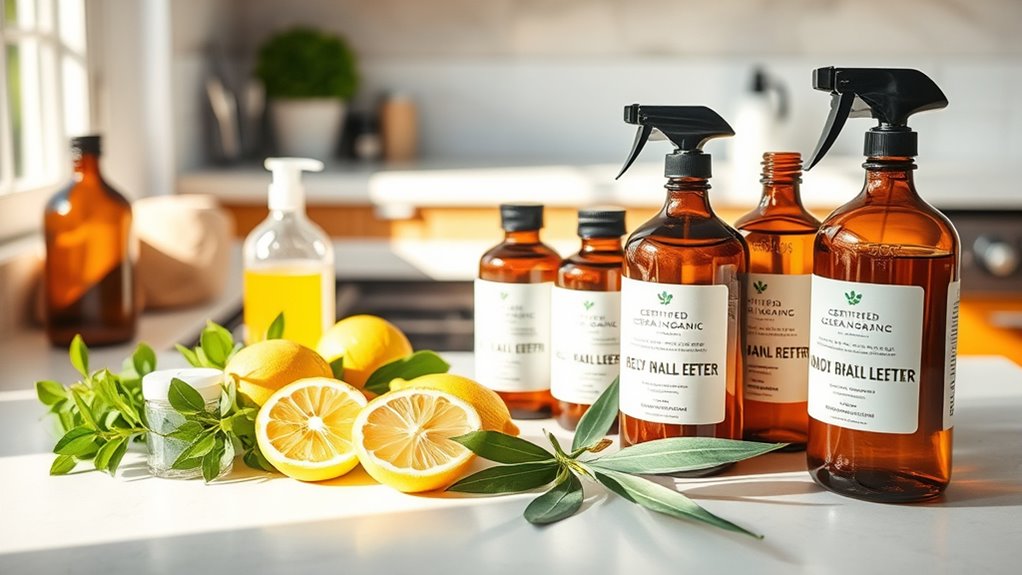
How can you guarantee that the cleaning products you choose are truly safe and environmentally sustainable? Start by checking for trusted eco-labels like EPA Safer Choice, Green Seal, or Leaping Bunny. These certifications verify that products meet strict safety, biodegradability, and cruelty-free standards, reducing your risk of greenwashing. Look for products made with plant-based, non-toxic ingredients that are biodegradable and free from harmful chemicals. Avoid those with synthetic fragrances, dyes, or VOCs, which can harm your health and the environment. Reading labels carefully helps you understand what’s inside. Supporting certified brands not only ensures your home stays toxin-free but also promotes sustainable practices in manufacturing. Making informed choices empowers you to create a safer, greener home environment for everyone.
Tips for Proper Ventilation and Storage of DIY Cleaners

Ensuring proper ventilation and storage is essential when using DIY cleaners to keep your home safe and your ingredients effective. Good airflow helps disperse any fumes and reduces potential sensitivities. Store your cleaners in airtight containers, preferably glass bottles, away from sunlight and heat, which can degrade natural ingredients. Keep labels clear to avoid accidental misuse. Consider these tips:
- Use well-ventilated areas during and after cleaning
- Store cleaners out of reach of children and pets
- Label homemade products with ingredients and date
- Avoid mixing incompatible ingredients like vinegar and bleach
- Keep containers sealed tightly to prevent spills and contamination
Avoiding Common Pitfalls and Ensuring Safe, Effective Green Cleaning

Avoiding common pitfalls is essential to make your green cleaning efforts both safe and effective. First, always verify labels and certifications to avoid greenwashing—rely on trusted seals like EPA Safer Choice or Green Seal. Don’t assume all natural ingredients are completely safe; some can cause allergies or sensitivities. Keep homemade cleaners fresh by storing them properly and using them promptly, as they may have a shorter shelf life. Never mix vinegar with bleach or other harsh chemicals, as dangerous gases can form. Ensure good ventilation during cleaning to reduce inhalation risks, even with natural products. Finally, test new cleaners on small surfaces first to prevent damage. Combining these practices will help you avoid pitfalls and maximize the safety and effectiveness of your green cleaning routine.
Frequently Asked Questions
Can DIY Natural Cleaners Replace All Conventional Cleaning Products?
Yes, DIY natural cleaners can replace most conventional cleaning products, especially for routine tasks like surface cleaning, deodorizing, and scrubbing. You can mix vinegar, baking soda, and essential oils for effective, non-toxic solutions. However, for heavy-duty disinfecting or deep cleaning, some commercial products with stronger formulations might be more effective. Always consider the cleaning task and make sure your DIY solutions meet safety and performance needs.
How Long Do Homemade Natural Cleaners Typically Last?
Homemade natural cleaners typically last between one week to a few months, depending on ingredients and storage. You might find yourself needing to make fresh batches often, especially for solutions with perishable components like citrus-infused vinegar or hydrogen peroxide. Proper storage in airtight, dark bottles prolongs their shelf life, but always check for signs of spoilage or separation before use. Staying vigilant ensures your DIY cleaners stay effective and safe.
Are Natural Ingredients Safe for Pets and Children?
Yes, natural ingredients are generally safer for pets and children, but you should still exercise caution. Some essential oils, like tea tree and citrus, can be toxic if ingested or applied directly in high concentrations. Always dilute ingredients properly, keep homemade cleaners out of reach, and observe your pets and kids for any signs of irritation or adverse reactions. When in doubt, consult your veterinarian or pediatrician.
What Are the Best Eco-Friendly Storage Containers for DIY Cleaners?
You’ll want to choose eco-friendly storage containers that are BPA-free and biodegradable, as over 55% of consumers now prioritize sustainability. Glass bottles with airtight lids are ideal because they’re reusable, non-toxic, and won’t leach chemicals into your cleaners. Stainless steel containers also work well, offering durability and safety. Avoid plastic that’s not labeled BPA-free, since it can degrade and release harmful substances over time, compromising your natural cleaning routine.
How Can I Tell if a Product Is Genuinely Eco-Certified?
To tell if a product is genuinely eco-certified, look for trusted labels like EPA Safer Choice, Green Seal, or Leaping Bunny on the packaging. These certifications guarantee the product meets strict environmental and safety standards. Always verify the certifying organization’s credentials online if you’re unsure. Avoid products without clear eco-labels or with vague claims, and check for specific details about their sustainable and non-toxic ingredients.
Conclusion
By choosing natural ingredients, creating simple solutions, and practicing safe storage, you can clean confidently, protect your family, and protect the planet. By using common pantry staples, infusing freshness, and avoiding harmful chemicals, you make cleaning easier, healthier, and more sustainable. With thoughtful preparation, consistent habits, and mindful choices, you turn your home into a toxin-free haven—clean, green, and safe for everyone who lives there.
